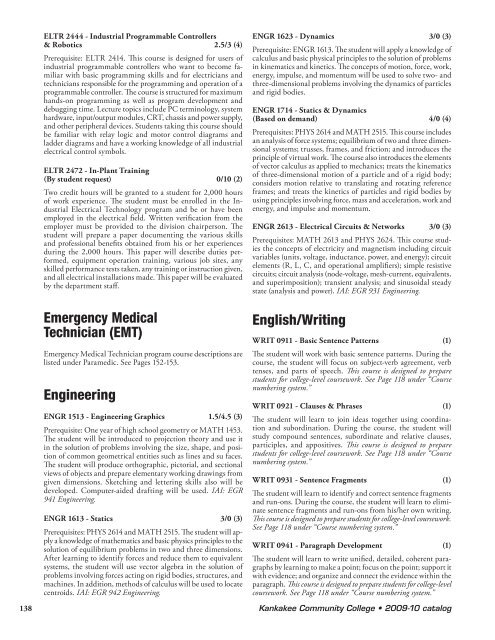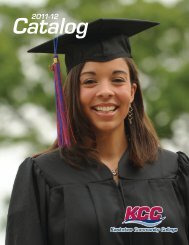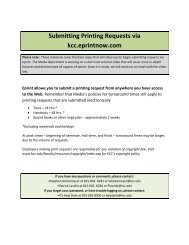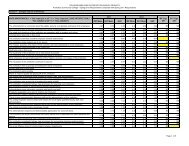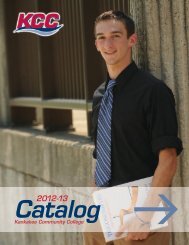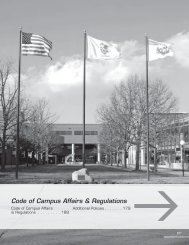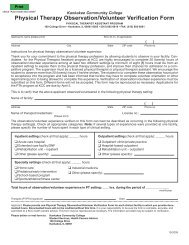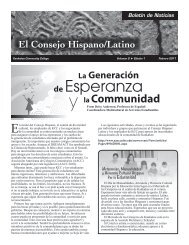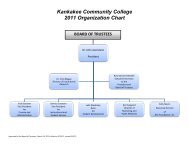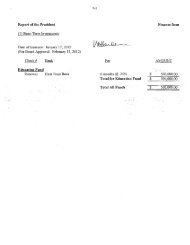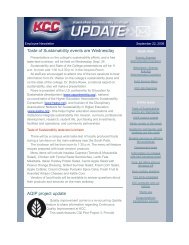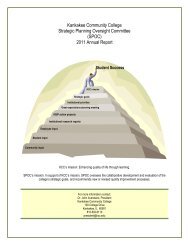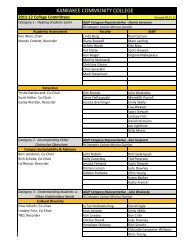09-10_Academiccatalog(Fullcatalog4.30mb) - Kankakee ...
09-10_Academiccatalog(Fullcatalog4.30mb) - Kankakee ...
09-10_Academiccatalog(Fullcatalog4.30mb) - Kankakee ...
You also want an ePaper? Increase the reach of your titles
YUMPU automatically turns print PDFs into web optimized ePapers that Google loves.
ELTR 2444 - Industrial Programmable Controllers<br />
& Robotics 2.5/3 (4)<br />
Prerequisite: ELTR 2414. This course is designed for users of<br />
industrial programmable controllers who want to become familiar<br />
with basic programming skills and for electricians and<br />
technicians responsible for the programming and operation of a<br />
programmable controller. The course is structured for maximum<br />
hands-on programming as well as program development and<br />
debugging time. Lecture topics include PC terminology, system<br />
hardware, input/output modules, CRT, chassis and power supply,<br />
and other peripheral devices. Students taking this course should<br />
be familiar with relay logic and motor control diagrams and<br />
ladder diagrams and have a working knowledge of all industrial<br />
electrical control symbols.<br />
ELTR 2472 - In-Plant Training<br />
(By student request) 0/<strong>10</strong> (2)<br />
Two credit hours will be granted to a student for 2,000 hours<br />
of work experience. The student must be enrolled in the Industrial<br />
Electrical Technology program and be or have been<br />
employed in the electrical field. Written verification from the<br />
employer must be provided to the division chairperson. The<br />
student will prepare a paper documenting the various skills<br />
and professional benefits obtained from his or her experiences<br />
during the 2,000 hours. This paper will describe duties performed,<br />
equipment operation training, various job sites, any<br />
skilled performance tests taken, any training or instruction given,<br />
and all electrical installations made. This paper will be evaluated<br />
by the department staff.<br />
Emergency Medical<br />
Technician (EMT)<br />
Emergency Medical Technician program course descriptions are<br />
listed under Paramedic. See Pages 152-153.<br />
Engineering<br />
ENGR 1513 - Engineering Graphics 1.5/4.5 (3)<br />
Prerequisite: One year of high school geometry or MATH 1453.<br />
The student will be introduced to projection theory and use it<br />
in the solution of problems involving the size, shape, and position<br />
of common geometrical entities such as lines and su faces.<br />
The student will produce orthographic, pictorial, and sectional<br />
views of objects and prepare elementary working drawings from<br />
given dimensions. Sketching and lettering skills also will be<br />
developed. Computer-aided drafting will be used. IAI: EGR<br />
941 Engineering.<br />
ENGR 1613 - Statics 3/0 (3)<br />
Prerequisites: PHYS 2614 and MATH 2515. The student will apply<br />
a knowledge of mathematics and basic physics principles to the<br />
solution of equilibrium problems in two and three dimensions.<br />
After learning to identify forces and reduce them to equivalent<br />
systems, the student will use vector algebra in the solution of<br />
problems involving forces acting on rigid bodies, structures, and<br />
machines. In addition, methods of calculus will be used to locate<br />
centroids. IAI: EGR 942 Engineering.<br />
ENGR 1623 - Dynamics 3/0 (3)<br />
Prerequisite: ENGR 1613. The student will apply a knowledge of<br />
calculus and basic physical principles to the solution of problems<br />
in kinematics and kinetics. The concepts of motion, force, work,<br />
energy, impulse, and momentum will be used to solve two- and<br />
three-dimensional problems involving the dynamics of particles<br />
and rigid bodies.<br />
ENGR 1714 - Statics & Dynamics<br />
(Based on demand) 4/0 (4)<br />
Prerequisites: PHYS 2614 and MATH 2515. This course includes<br />
an analysis of force systems; equilibrium of two and three dimensional<br />
systems; trusses, frames, and friction; and introduces the<br />
principle of virtual work. The course also introduces the elements<br />
of vector calculus as applied to mechanics; treats the kinematics<br />
of three-dimensional motion of a particle and of a rigid body;<br />
considers motion relative to translating and rotating reference<br />
frames; and treats the kinetics of particles and rigid bodies by<br />
using principles involving force, mass and acceleration, work and<br />
energy, and impulse and momentum.<br />
ENGR 2613 - Electrical Circuits & Networks 3/0 (3)<br />
Prerequisites: MATH 2613 and PHYS 2624. This course studies<br />
the concepts of electricity and magnetism including circuit<br />
variables (units, voltage, inductance, power, and energy); circuit<br />
elements (R, L, C, and operational amplifiers); simple resistive<br />
circuits; circuit analysis (node-voltage, mesh-current, equivalents,<br />
and superimposition); transient analysis; and sinusoidal steady<br />
state (analysis and power). IAI: EGR 931 Engineering.<br />
English/Writing<br />
WRIT <strong>09</strong>11 - Basic Sentence Patterns (1)<br />
The student will work with basic sentence patterns. During the<br />
course, the student will focus on subject-verb agreement, verb<br />
tenses, and parts of speech. This course is designed to prepare<br />
students for college-level coursework. See Page 118 under “Course<br />
numbering system.”<br />
WRIT <strong>09</strong>21 - Clauses & Phrases (1)<br />
The student will learn to join ideas together using coordination<br />
and subordination. During the course, the student will<br />
study compound sentences, subordinate and relative clauses,<br />
participles, and appositives. This course is designed to prepare<br />
students for college-level coursework. See Page 118 under “Course<br />
numbering system.”<br />
WRIT <strong>09</strong>31 - Sentence Fragments (1)<br />
The student will learn to identify and correct sentence fragments<br />
and run-ons. During the course, the student will learn to eliminate<br />
sentence fragments and run-ons from his/her own writing.<br />
This course is designed to prepare students for college-level coursework.<br />
See Page 118 under “Course numbering system.”<br />
WRIT <strong>09</strong>41 - Paragraph Development (1)<br />
The student will learn to write unified, detailed, coherent paragraphs<br />
by learning to make a point; focus on the point; support it<br />
with evidence; and organize and connect the evidence within the<br />
paragraph. This course is designed to prepare students for college-level<br />
coursework. See Page 118 under “Course numbering system.”<br />
138 <strong>Kankakee</strong> Community College • 20<strong>09</strong>-<strong>10</strong> catalog


